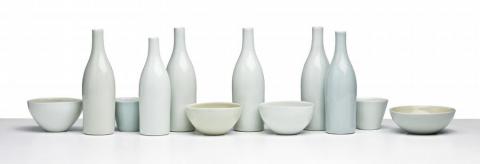STILL LIFE WITH FOUR BOWLS, 1998
Gwyn Hanssen Pigott
porcelain, 12 pieces (6 bottles, 4 bowls, 2 beakers)
100.0 cm length
each bottle stamped with roundel on base
Christine Abrahams Gallery, Melbourne
Private collection, Melbourne
Gwyn Hanssen Pigott, Christine Abrahams Gallery, 7 November – 3 December 1998, cat. 7
...Beauty, and our response to it, remains a mystery. But it seems to me that, in the alchemy of making, the pot becomes subtly humanised. It is as though a kind of knowing is translated - through care and consideration, and an intimate connecting with the stuff under our fingers, the fluidity, the resistance, the wetness, the toughness - into a form with an independent life, with its own power to move... So we speak of pots as though they are animate: we call them gentle or generous or strong or vulnerable.'1
One of Australia's most successful ceramic artists, Gwyn Hanssen Pigott is revered internationally for the abstract simplicity of her meditative porcelain assemblies that epitomise the concept of shibui or 'truth beauty' espoused by her mentor Bernard Leach - 'honesty, ordinariness, nobility, simplicity, humility, astringency'.2 Profoundly inspired by Leach, and other modernist potters such as Lucie Rie and Michael Cardew, these poised groupings of smooth-sided vessels, bowls and bottles are also highly evocative of Giorgio Morandi's transcendent still life studies, sharing an affinity in their composition, stillness and meticulous attention to form.
A metaphorical work encapsulating the artist's enduring interest in social relations, movement and travel, the present Still Life with Four Bowls 1998 thus conveys a powerful sense not only of passage, but also, of purpose - shifting beyond the idea of the still life to evoke identities that occupy and move within their own space amidst the collective whole. Yet as Hanssen Pigott continually reminds her audience, such groupings are also ordinary domestic objects, '...just pots, that some days we might not look at twice. But they have for a moment pulled on our attention with, perhaps, a reminder of our own vulnerability, and beauty, and possibility of transformation and repose.'3
1. Hanssen Pigott, G., Object of Ideas: Ten Approaches to Contemporary Craft Practice, Queensland, 1996.
2. Leach cited in Gwyn Hanssen Pigott: Caravan, a parade of beakers, bottles, bowls, jugs and cups, Tate St Ives, England, 2004, p. 3
3. Hanssen Pigott, op.cit.
VERONICA ANGELATOS
